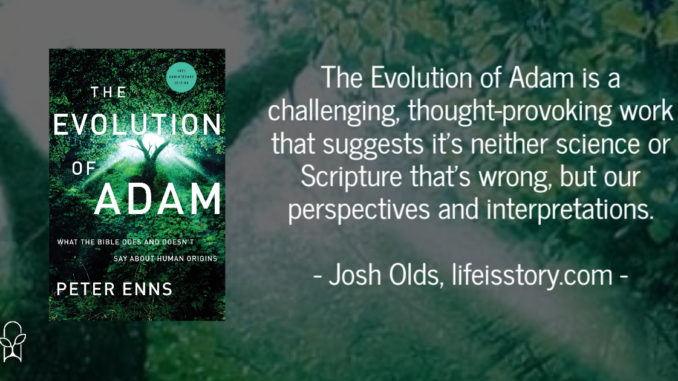
Published by Brazos Press on October 19, 2021
Genres: Academic, Non-Fiction, Theology
Buy on Amazon
Goodreads

Can Christianity and evolution coexist? Traditional Christian teaching presents Jesus as reversing the effects of the fall of Adam. But an evolutionary view of human origins doesn't allow for a literal Adam, making evolution seemingly incompatible with what Genesis and the apostle Paul say about him. For Christians who both accept evolution and want to take the Bible seriously, this can present a faith-shaking tension.
Popular Old Testament scholar Peter Enns offers a way forward by explaining how this tension is caused not by the discoveries of science but by false expectations about the biblical texts. In this 10th anniversary edition, Enns updates readers on developments in the historical Adam debate, helping them reconcile Genesis and Paul with current views on evolution and human origins. This edition includes a foreword on the need for a new edition and an afterword that explains Enns's own theological evolution since the first edition released.
It’s been ten years since Peter Enns released The Evolution of Adam, a groundbreaking work that explored the possibility that a faithful reading of Scripture could be aligned with evolutionary theory. Now, in a revised edition, Enns offers his work to a new generation, coinciding with a resurgence of focus on the topic. I’ve done a lot of reading on the historical Adam recently (see The Genealogical Adam and Eve by Swamidass or In Quest of the Historical Adam by Craig, among others) and this was the first to be theologically compelling.
Enns writes as an academic. He doesn’t offer final conclusions or definite statements. Instead, he faithfully seeks a way to reconcile our interpretation of Scripture with our interpretation of science—and rethink what we should expect from Scripture. Enns sees four possible options:
- Accept evolution and reject Christianity.
- Accept Paul’s view of Adam as binding and reject evolution.
- Reconcile evolution and Christianity by positing a first human pair (or group) at some point within the evolutionary process.
- Rethink Genesis and Paul.
Enns favors this fourth option, suggesting that we need to reevaluate what we have the right to expect from Genesis and Paul. Part one of the book is a reevaluation of Genesis, its reason for being written, its genre of literature, and so on. This is an important thing to discuss. While fundamentalists might say “When the plain reading of Scripture makes sense, seek no other sense.” But a plain reading, or a literal reading, is not always the correct reading. It is incorrect to literally interpret something intended as symbolism. Enns makes the case that the Creation narrative, being poetry, should be viewed differently than other genres of literature like history. He spends a fair amount of time diving into other Ancient Near Eastern creation myths and linking them to the Genesis narrative. Enns oversells that point, in my estimation, but his insistence that we interpret Ancient Near Eastern literature in an Ancient Near Eastern context makes a lot of sense and helps readers view the narrative from a non-Western lens.
The second half of the book, discussing the New Testament’s view of Adam (Paul’s in particular) is very enlightening as Enns places Paul in his own context of first century Judaism and how that affects his interpretation of Genesis and informs how he writes about Adam and creation. In particular, The Evolution of Adam focuses on Romans 5 and Paul’s use of Adam as a theological figure. Again, the question that is asked is whether or not Adam is being used symbolically or literally in comparison to Jesus. Enns is able to rather convincingly separate the truthfulness of Paul’s theology (and Christ’s historicity) from the historical Adam or a literal young-earth creationism.
Enns finishes with nine conclusions, summarized here:
- Literalism isn’t an option. That is, the Bible isn’t always supposed to be interpreted literally and it is wrong to do so when the authors intended a different interpretation.
- Scientific and biblical models of human origins are incompatible because they have different goals. That is, we must hold the tension between the two and understand that full reconciliation will be impossible.
- The creation story in Genesis reflects its ANE setting. That is, Scripture should be interpreted contextually.
- There are two creation stories in Genesis. Genesis 2 is the older one and subsumed under Genesis 1 after the exile. This assumes a bit too much for my taste, suggesting that Genesis 1 is a post-exilic creation. However, there is no doubt that Genesis 1 and 2 are different retellings of the same event.
- The story of Adam is about a failure to fear God and attain wise maturity. In particular, Enns compares Adam’s story to the Proverbs, showing how the story of the fall symbolically represents the struggle of all people.
- God’s solution to sin through Jesus reveals the deep foundational plight of the human condition. This is what leads Paul to compare Jesus to Adam
- A proper view of inspiration will embrace the fact that God speaks through cultural idiom. In this way Enns is able to uphold a high view of Scripture.
- The root of the creation/evolution conflict is more based on losing power in the culture wars than any theological or scientific disagreement. This one hits hard.
- Reconciling evolution and Christianity means developing a synthesis between the two, not adding one to the other.
In conclusion, while I’m not convinced of every point that The Evolution of Adam makes, Peter Enns offers a reasonable way for believers to uphold the integrity of Scripture while also taking modern science into consideration. It’s not a compromise or a concession, it’s a way of considering truth wherever it is found and trying to be as faithful as possible. It’s a challenging, thought-provoking work that suggests that it’s neither Scripture nor science that’s wrong but our perspectives and interpretations.
